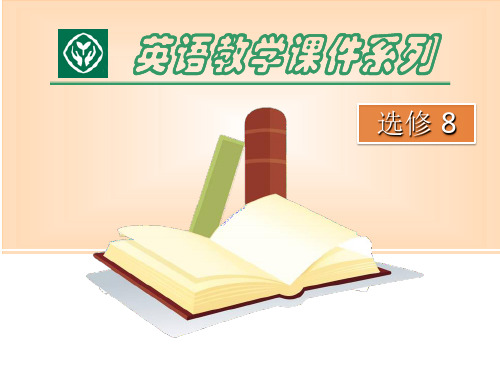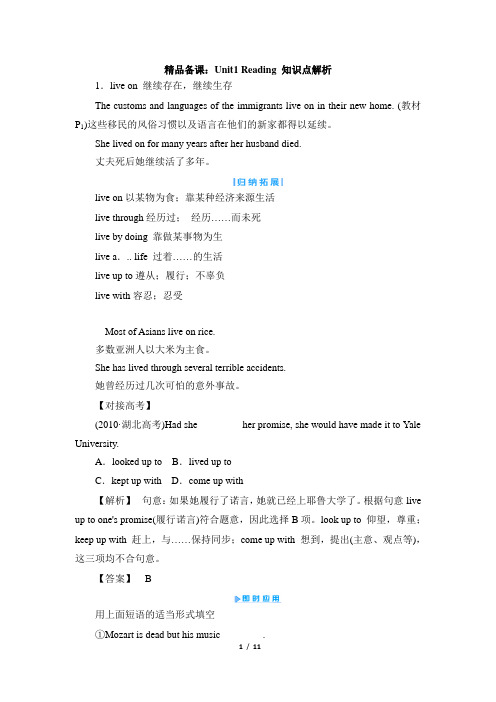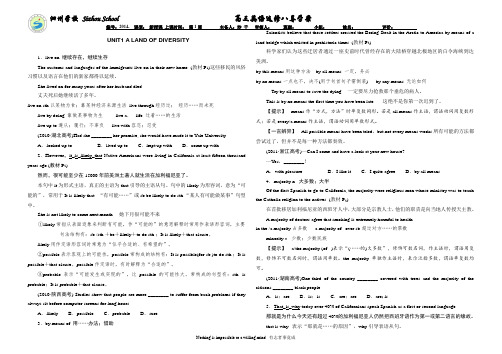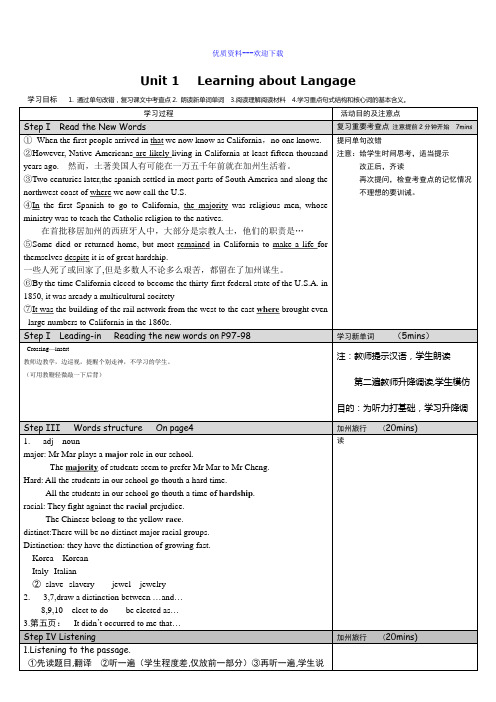选修八unit1知识点说课讲解
高中英语 选修8 语言点讲解Unit 1 A land of diversity

no distinct major racial
在考试中的成绩不好。
or cultural groups, but simply a mixture of many races and cultures. 人们认为,要不了多久,
that
从句。
_I_t_'_s_b_e_li_e_v_e_d_t_h_a_t___ _te_e_n_a_g_e_r_s_w__it_h_o_u_t___ h_a_v_i_n_g__b_r_ea_k__fa_s_t_w__il_l _ _n_o_t_o_n_l_y_f_a_ll_a_s_l_ee_p__
mind. 3.A signal may be given by means of flags, lights, and guns. 4.If you team up with your classmates, you will surely get the
same work done far better. 5.These teenagers don't know much of the world yet; that's
显然地;显而易见地 14.conductor n.(公车)售票员;列车员;(乐队)指挥→_c_on__d_u_c_t v.
管理 15.slip vi.滑动;滑行;滑跤 n.滑动;滑倒 → slippery adj.滑的 16.punishment n.惩罚;处罚→ punish vt.惩罚;处罚
[语境活用]
多种国籍的混合将会非
_e_a_si_l_y_i_n_c_l_a_ss__, but
常之大,以至于不可能存
concentrate less on
在一种明显的、主要的种
人教版英语选修八unit1Reading知识讲解

California dreaming!
On such a winter’s day! Stopped into a church.
I passed along the way.
Well I got down on my knees.
And I pretend to pray. I pretend to pray.
选修 8
Unit 1 A land of diversity
Reading
California dreaming
Байду номын сангаас
All the leaves are brown. And the sky is grey.
I’ve been for a walk.
On a winter’s day.
I’d be safe and warm. If I was in L.A.
You know the preacher likes the cold.
He knows I’m gonna stay.
If I didn’t tell her.
I could leave today.
Pre-reading
CALIFORNIA (the Golden State) Lying on the Pacific Ocean, California is on the west coast of the United States, which is diverse in topography(地形), climate and ecological environment. It has an area of 411 square kilometers,
A. the Ohio River B. the Colorado River C. The Missouri River
高中英语选修八unit1词汇精讲课

3. 完成句子
①那就是他出生的地方。
That is where he was born. _____________
②当时天正下着雨,那正是我迟到的原因。 That was why I was late. It was raining then. _____________
【拓展】take for take off take on take up take over take back
当做;误认为 脱衣服;(飞机)起飞;成功 呈现;雇用;承担 占据;从事;继续;拿起 接管 撤回;同意收回
【真题链接】 Some insects ______ the colour of their surroundings to protect themselves. A. take in B. take off C. take on D. take out
她决定当律师。
②We elected James (to be/as) chairman. 我们选举詹姆斯当主席。
【归纳】elect to do sth.
决定做某事
__________
推选某人担任某职务
elect sb. (to be/as)+职务 __________________
【点津】 “ 独一无二的”职务、官衔作同位语、补语、表
主语或it作形
式主语 人
3. by means of. . . 用„„办法;借助„„ I found my bike by means of a notice in the newspaper. 我借助于报纸上的一则通知找到了我的自行车。 【拓展】翻译以下短语 by this means by no means by all means 用这种方法 ___________ 决不;一点也不 _______________
人教课标版高中英语选修8 精品备课:Unit1_Reading_知识点解析

精品备课:Unit1 Reading 知识点解析1.live on 继续存在,继续生存The customs and languages of the immigrants live on in their new home. (教材P1)这些移民的风俗习惯以及语言在他们的新家都得以延续。
She lived on for many years after her husband died.丈夫死后她继续活了多年。
live on以某物为食;靠某种经济来源生活live through经历过;经历……而未死live by doing 靠做某事物为生live a... life 过着……的生活live up to遵从;履行;不辜负live with容忍;忍受Most of Asians live on rice.多数亚洲人以大米为主食。
She has lived through several terrible accidents.她曾经历过几次可怕的意外事故。
【对接高考】(2010·湖北高考)Had she ________ her promise, she would have made it to Yale University.A.looked up to B.lived up toC.kept up with D.come up with【解析】句意:如果她履行了诺言,她就已经上耶鲁大学了。
根据句意live up to one's promise(履行诺言)符合题意,因此选择B项。
look up to 仰望,尊重;keep up with 赶上,与……保持同步;come up with 想到,提出(主意、观点等),这三项均不合句意。
【答案】 B用上面短语的适当形式填空①Mozart is dead but his music ________.②My grandfather ________ both world wars.③We should work hard and try to ________ our parents' expectations.④The brave girl is learning to ________ her disability.【答案】①lives on②lived through③live up to④live with2.However,it is likely that Native Americans were living in California at least fifteen thousand years ago.(教材P2)然而,很可能至少在15000年前美洲土著人就生活在加利福尼亚了。
(完整版)选修8UNIT1词汇讲解

泗州学校Sizhou School高三英语选修八导学案编号:2014- 课型:新授课上课时间:第1周主备人:沙千审核人:班级:小组:姓名:评价:UNIT1 A LAND OF DIVERSITY1.live on 继续存在,继续生存The customs and languages of the immigrants live on in their new home. (教材P1)这些移民的风俗习惯以及语言在他们的新家都得以延续。
She lived on for many years after her husband died.丈夫死后她继续活了多年。
live on sth以某物为食;靠某种经济来源生活live through经历过;经历……而未死live by doing 靠做某事物为生live a... life 过着……的生活live up to遵从;履行;不辜负live with容忍;忍受(2010·湖北高考)Had she ________ her promise, she would have made it to Yale University.A.looked up to B.lived up to C.kept up with D.come up with2.However,it_is_likely_that Native Americans were living in California at least fifteen thousand years ago.(教材P2)然而,很可能至少在15000年前美洲土著人就生活在加利福尼亚了。
本句中it为形式主语,真正的主语为that引导的主语从句。
句中的likely为形容词,意为“可能的”,常用于It is likely that...“有可能……”或sb.be likely to do sth.“某人有可能做某事”句型中。
高中英语人教版选修八 Unit 1 Learning about Langage 讲义

优质资料---欢迎下载Unit 1 Learning about Langage学习目标 1. 通过单句改错,复习课文中考查点2. 朗读新单词单词 3.阅读理解阅读材料 4.学习重点句式结构和核心词的基本含义。
学习过程活动目的及注意点Step I Read the New Words 复习重要考查点注意提前2分钟开始7mins①When the first people arrived in that we now know as California,no one knows.②However, Native Americans are likely living in California at least fifteen thousand years ago. 然而,土著美国人有可能在一万五千年前就在加州生活着。
③Two centuries later,the spanish settled in most parts of South America and along the northwest coast of where we now call the U.S.④In the first Spanish to go to California, the majority was religious men, whose ministry was to teach the Catholic religion to the natives.在首批移居加州的西班牙人中,大部分是宗教人士,他们的职责是…⑤Some died or returned home, but most remained in California to make a life for themselves despite it is of great hardship.一些人死了或回家了,但是多数人不论多么艰苦,都留在了加州谋生。
人教版高中英语选修8U1知识详解
Unit1 A land of diversity基础落实Ⅰ.高频单词思忆1.He has twenty head of (牛) on his farm.2.He has six pieces of (行李).3. (显然),she has lost interest in physics.4.She had the (不同) of being the first woman to swim the Channel.5.Please (投入) a coin in/into the slot.6.We’d better h a car for the weekend.7.Those a who want to get the job are required to present their resume this month.8.The health a are investigating the problem.9.Research i that eating habits are changing fast.10.They failed to g the importance of his words.cattle luggage apparently distinction insert hire applicants authorities indicates graspⅡ.重点短语再现1. 用……方法;借助……2. 坚持;维持;沿袭(风俗、传统等)3. 与某人合作或一起工作4. 包括;吸收5. 继续存在6. 习惯于新的生活方式、工作等7. 申请;请示得到8. 背靠背9. 划线;标出……界线10. 许多Ⅲ.典型句式运用1.However,it is likely that Native Americans were living in California atleast fifteen thousand years ago.然而,土著美国人很可能在一万五千年前就在加州生活着。
人教版新课标选修8第1单元精讲讲义(附答案)
人教版新课标选修8各单元精讲讲义选修8第1单元Ⅰ. 要点导读1. Of the first Spanish to go to California, the majority were religious men who came to teach the Catholicreligion to the natives. (P2)majority n.“多数人”,多和定冠词the连用。
表示“(投票时的) 多数”时,可加不定冠词。
其本意为“大部分;大多数”。
eg: The majority of the committee are strongly against the decision.His party did not win a majority in Parliament.The majority of soil was carried away by the floods.in the majority“占大多数”eg: People who can sing and dance are in the majority in my company.2. It is believed that before long the mix of nationalities will be so great that there will be on major racial orculturalgroups,…(P3) mix(1) n. [C]“结合;混合”,常用单数形式。
eg: The liquid is a mix of Coca-Cola and coffee.(2) v.“混合;拌和”,mix A with B = mix A and B together“把A和B混合起来”eg: Please help me to mix butter and sugar together.Oil does not mix with water.mixture n.“混合物;混合”eg: Shake the mixture before taking it.We listened to the news with a mixture of surprise and horror.3. Why is it important in a telephone conversation to indicate that you are paying attention to what theotherpersonissaying?(P7) indicate v.“暗示”,后可接名词、代词或从句eg: A sky with no cloud indicates fine weather the next day.The results indicate that this product is enjoying a greatsuccess.indication n.“表明;迹象;说明”eg: He gave no indication of his own thoughts at all.There was no indication this morning that it would rain.4. Apparently he’d been shocked when he saw a terrible accident in which a tram slipped down the hill. (P8)apparently adv.“显然地;显而易见地”eg: She managed to climb out of the car, apparently unhurt.I thought they had divorced, but apparently they haven’t.apparent adj.“显而易见的;显然”eg: Her anxiety was apparent to everyone.It’s apparent that you can’t be trusted.5. … noticing how the listener reacts and, … (P9)react vi.“作出反应;回应”react against“反抗;抗拒”eg: The workers reacted against the rules made by the new boss.react to“对……作出反应”eg: How did Wilson react to your idea?reaction n.“反应;回应”eg: What is your reaction to this plan?6. Scientists believe that these first settlers crossed by Bering Strait from Asia to Alaska by means of a landbridge which existed in prehistoric times. (P2)by means of“用……方法;借助……”eg: Thoughts are expressed by means of words.This is a two-year course taught by means of lectures and seminars.by all means“无论如何;务必”eg: Hand in your homework by all means tomorrow.by no means“决不;一点都不”eg: By no means will he have the good chance to study abroad.7. Many died or returned home, but most remained in California to make a life for themselves in the newtownsoronfarms.(P2) make a life = make a living“谋生”eg: Nowadays, many teenagers are going to make a life during the summer vacation.make / earn / get a living“谋生”eg: He made a living by selling newspapers.He wanted to earn his own living after graduation.lead / live … a life“过着……的生活”eg: She led a wonderful life. The poor old man lived a hardlife.8. It didn’t occur to me that there’d be a big festival on at the same time as my holiday. (P5)occur to“(某人)想到”eg: A good idea occurred to / came to / struck him.occur to经常用于以it作形式主语的句子中,真正的主语可以是不定式,也可以是从句。
高中英语Unit 1 课文重难点解析新人教版选修8
高中英语Unit 1 课文重难点解析新人教版选修8Unit 1 课文重难点解析选修8Unit 1 课文重难点解析在新人教版选修8的第一单元中,有一篇名为《Health》的课文,本文将对该课文进行重难点解析。
本单元的课文以“健康”为主题,主要围绕人们如何保持健康展开论述。
下面将从课文的结构、语法、词汇、阅读理解和写作技巧等方面进行解析。
一、课文结构《Health》这篇文章共分为三个部分,分别是“Warming up”、“Reading”和“Language points”。
每个部分都有不同的设计和重点。
其中,“Warming up”部分通过与学生的互动帮助学生进入主题,并激发对健康话题的兴趣。
而“Reading”部分则是通过一篇关于健康的文章,让学生了解更多有关保持健康的知识。
最后的“Language points”部分对语法、词汇和阅读理解中出现的难点进行了总结和阐述。
这种结构使得学生可以在不同层面上掌握相关知识。
二、语法解析在这篇课文中,存在一些语法知识点,让我们一起来进行解析。
1.名词的复数形式在课文中有一句“Not only is it imp ortant to keep a healthy mind, but itis also important to keep healthy bodies.”,这里的“bodies”是“body”的复数形式,表示多个身体。
这提醒我们英语中的名词有单数和复数之分,需要根据具体情况使用正确的形式。
2.动词的时态在课文中有一句“Exercise helps to keep the heart healthy and prevents heart disease.”中的“helps”和“prevents”都是动词的第三人称单数形式,表示一般现在时。
这表明英语动词根据主语的不同需使用相应的时态形式。
3.形容词的比较级和最高级形式在课文中有一句“Exercise and a balanced diet are important, but sleeping well is even more important.”这里的“more important”和“even more important”表示比较级和最高级形式,用于进行比较。
选修8Unit1知识点课件.
13. a large percentage have chosen…= a large percentage of Chinese-Americans have chosen… ...
1). A large percentage of population live in big cities.
now the state of Virginia.
A.which B. where C. that D. what
= George Washington was born in
the place that is now the state of Virginia.
1.Pudong Development Zone is no longer a rural area ________ it used to be. C 定语从句, 先行词是area, that作关系代词
7. force …into …强迫…成为、做、进入…
They forced him into signing (to sign) the paper. He forced his feet into his shoes. She was forced into crime by circumstances. 她为境遇所迫而犯罪。 The fellow forced his way into my home. 那家伙强行闯入我家。
establish a new business
The / A majority of the country speak(s) English. The / A majority of students were/was against the policy. The majority is / are always able to impose (强加)its/ their will on the minority.
- 1、下载文档前请自行甄别文档内容的完整性,平台不提供额外的编辑、内容补充、找答案等附加服务。
- 2、"仅部分预览"的文档,不可在线预览部分如存在完整性等问题,可反馈申请退款(可完整预览的文档不适用该条件!)。
- 3、如文档侵犯您的权益,请联系客服反馈,我们会尽快为您处理(人工客服工作时间:9:00-18:30)。
选修八u n i t1知识点选修八Unit 1 A land of diversity 单元要点预览(旨在让同学整体了解本单元要点)Ⅰ.词语辨析(旨在提供完形填空所需材料)Ⅱ.词性变化(旨在提供语法填空所需材料)Ⅲ.重点词汇(旨在提供词汇综合运用所需材料)1.majority n.大多数;大半 major adj.&n.较大的,主要的;主修,专攻(反义词minority少数;少数民族)[典例]1). A / The majority of doctors agree that smoking is extremely harmful to health. 大多数医生认为吸烟对健康极为有害。
2). The majority was/were in favour of the proposal. 多数人赞成这个建议。
[重点用法]be in the/a majority 构成大部分/大多数 a majority over sb 超过对方的票数2. applicant n.申请人 application n.申请(书);应用;用途 apply v. 申请;运用,适用[典例]1). We had 250 applicants for the job. 有250人申请这份工作。
2). As the wages were low, there were few applicants for the job. 因为工资低, 没有什麽人申请这份工作。
[重点用法]apply for... 申请…… apply to... 适用……fill in the application form for sth. 填写……申请表[练习] 根据句子的要求在括号里填入适当的词或翻译。
1). Successful _________ (apply) will receive notification within the week.2). This rule can’ t be applied ________ (介词) every case.3). You should ________ ________(申请) the job immediately, in person or by letter.4). The question in the second half of the form _________ ________ (适用) married men only.Keys: 1). applicants 2). to 3). apply for 4). apply to3. occur vi. 发生;出现;存在[典例]1). The tragedy occurred only minutes after take-off. 这一悲剧在起飞后几分钟内就发生了。
2). Didn’ t it occur to you that he mi ght be late? 你当时没有想到他可能会迟到吗? [重点用法]occur to... (主意) 浮现于脑海中;被想到;被想起;(某人)想到……4. indicate vt. 指出;标示;表明indication n. 指出;表明indicative adj.指示的;暗示的[典例]1). I asked him where my sister was and he indicated the shop opposite. 我问他握姐姐在哪,他指指对面的商店。
2). Research indicates that men find it easier to give up smoking than women. 研究表明男人感到比女人更容易戒烟。
[重点用法]indicate sth (to sb) 指示;指出;标示indicate that/wh-表示……;示意……[练习] 根据句子的意思,在括号里填入适当的词。
1). The government has ________ (表明) that it intends to cut taxes.2). A flashing red light ________ (标示) that a stretch of road was undergoing repairs.3). There is every ________ (indicate) of a change in the weather.Keys: 1). indicated 2). indicated 3). indication5. slip vi.滑动;滑行;滑跤n. 滑倒;小过失;失误 slippery adj.滑溜的[典例]1). My foot slipped and I nearly fell. 我的脚一滑,差点跌到。
2). She slipped into the room when no one was looking. 她趁无人注意的时候溜进了房间。
[重点用法]let slip... 错过……;无意中说出 let sth. slip through your fingers错过(机会),失去(机会)a slip of the tongue 口误[练习] 根据句子的要求在括号里填入适当的词或翻译。
1). She ________ ________ (无意中说出) that she was intending to leave the company.2). As the years _________ by, I thought more and more about him.3). Drive very carefully; the roads are wet and ________ (slip).Keys: 1). let slip 2). slipped 3). slippery6. insert vt.插入,嵌入[典例]He inserted a key into a lock. 他把钥匙插进锁中。
[重点用法]insert sth (in/into/between sth) 插入、放入、置入或嵌於某物或某两物间Ⅳ.重点词组(旨在提供综合运用所需材料)1. live on 继续生活或存在[典例]She lived on for many years after her husband died. 丈夫死後她继续活了多年。
[短语归纳] live短语:live on sth 以某物为食;靠某种经济来源生活live by doing sth 靠做某事物为生live for sth 以某事物为生活目标live through sth 经历某事物而幸存live together 在一起生活;同 live a... life 过着……的生活live with sth 接受或容忍某现象live to be... = live to the age of... 活到……岁live up to sth 依照某事物行事;表现出符合某事物的标准[练习] 根据句子的意思在括号里填入适当的live短语。
1). The lonely old man _______ _______ charity.2). Mozart is dead but his music _______ _______.3). My grandfather _______ _______ both world wars.4). We should work hard and try to _______ _______ _______ our parents’ expectations.5). The brave girl is learning to _______ _______ her disability.Keys: 1). live on 2). lives on 3). lived through 4). live up to 5). live with2. make a life 习惯于新的生活方式、工作等[典例]They settled down in Canada and made a life for themselves.他们在加拿大定居下来,习惯新的生活方式。
[短语归纳] life短语:bring sb/sth (back) to life 给某人/事物的活力;使复活lay down one’ s life (for sb/sth) 为……献身;牺牲生命lead a dog’ s life 过狗一般的生活(长期忧虑、痛苦或悲伤)make one’ s way in life 在生活中有所成就take one’ s (own) life: commit suicide 自杀put an end to one’ s life: kill oneself 自杀take sb’ s life: kill sb 取某人性命a/sb’ s way of life(某人的或某些人的)生活方式end one’ s days/life (in sth)(处於某状况下或在某处)度过余生[练习] 根据句子的意思在括号里填入适当的介词或翻译。
1). He laid down his life _______ the cause of freedom.2). They interview people from _______ _______ _______ _______ (各行各业的人).3). She adapted easily to the French _______ _______ _______ (生活方式).Keys: 1). for 2). all walks of life 3). way of life3. keep up坚持;维持;沿袭古老的风俗、传统等;使某人不能去睡觉[典例]1). You’ re all doing a splendid job; keep up the good work! 你们干得都很出色, 要坚持下去!2). I do hope we’ re not keeping you up. 我希望我们没有耽误你睡觉。
[短语归纳] keep短语:keep up with sb/sth. 跟上(某人/某事物);、跟上(形势)keep (on) doing sth. 继续做某事物;重复做某事物keep away from(使某人/事物)不靠近某人/事物keep sb back from sb/sth(使某人)与某人/事物保持距离keep sth. back 阻止某事物keep oneself/sb from sth/doing sth 使自己/某人不能做某事物keep sth from sb 不将某事告诉某人keep off (sb/sth) 不接近或不接触某人/事物keep sb/sth out (of sth) 不让某人/物进入(某处)keep in touch with保持与某人的联系keep fit 保持健康[练习] 根据句子的要求在括号里填入适当的词。
